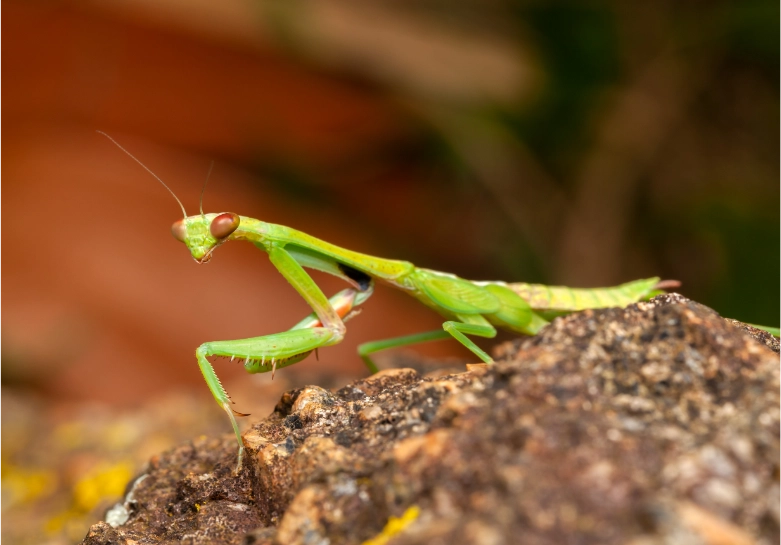The praying mantis is known as a ferocious predator in the animal kingdom (as far as insects are concerned, anyways). Armed with sharp pincers, razor sharp jaws, lightning-fast speed, and a voracious appetite, it is not a foe to meddle with.
Unless you are a much larger animal – like us humans, then the praying mantis is more of a creature of fascination rather than something to fear. Afterall, the praying mantis even has its own Kung Fu style. But one thing you might not learn to do in Kung Fu class is to spit out a venomous spray to blind and cripple someone.
Wait, can a praying mantis spit venom? Let’s find out.
Do Praying Mantis Spit Acid?
There has been a rumor about the praying mantis – that in addition to its already fearsome arsenal of weapons to use against its prey and assailants, it can also spit out a powerful acid to defend itself. This is simply not true. The praying mantis has no such venomous spit – or any type of venom at all for that matter to speak of.
I remember as a small child proudly showing my mother – who detests insects of all sizes, a small praying mantis I found in the backyard garden. She told me that if a praying mantis spits in my eye it can burn my eyes. Little did she know, not only was she playing into a false rumor about the mantis; she created a fear of a relatively harmless animal.
But how could this rumor have come to being in the first place? Did someone just see the praying mantis’ alien-like appearance and assume it should be able to spit a venomous goo that could melt through iron or something?
Lucky for you, I can explain.
The rumors that the praying mantis can spit acid or venom into your eyes and blind you were started after a walking stick was observed emitting a type of spray as a self-defense mechanism. While several species of walking sticks – totally different species from praying mantises; though they do look somewhat alike, are capable of secreting an acidic spray to fend off predators, no known species of praying mantis has such a defense mechanism.
Do Praying Mantises Even Spit at all?
Now that we have debunked the myth that the praying mantis can spit acid or some sort of venomous chemical, you might be wondering things like – Can they even spit at all? How far can a praying mantis spit? Can praying mantis spit blind you? When will a praying mantis spit on me?
There is no record of the praying mantis ever spitting period. Acid spit sounds painful; and normal spit sounds kind of gross – luckily, you don’t need to worry about either when it comes to the praying mantis.
Are Praying Mantises Dangerous to People?
While praying mantises are ruthless killers in the wild – to small insects anyways, are they dangerous to humans? Praying mantises are considerably smaller than your average human being – a 6-inch long praying mantis is considered large – so the odds of them hurting a human is unlikely.
As mentioned before, the praying mantis is armed with a fearsome set of claws and sharp, powerful jaws used to capture and devour its prey, which includes insects, small lizards, and even on rare occasion small hummingbirds. But that only works when your pray is small enough to be eaten, so human beings in general are in the clear.
Praying mantises are also safe to hold, as they are not prone to any kinds of infectious diseases that could spread to humans. If anything, it’s possible that if you mess with a praying mantis it might try to attack you with its claws or nibble on you with its teeth. But this is unlikely to hurt very much – if at all.
Praying mantises do not possess any kind of stinger, venom pouch, venomous fangs, or any real means to harm a human being or any animal significantly larger than it. You can rest assured that the next time you hold a praying mantis the worst thing that could come from it is perhaps a fecal surprise in your hand.
Insects That Do Have Venomous Spit
Now that we have cleared the praying mantis’ name and verified that it is not capable of even spitting – let alone spitting some type of venomous acid, let’s talk about some insects that actually can pose a threat with their spit.
Species of Ground Beetles
Species of beetles known as “ground beetles” which are bound to the ground as their name implies, have no wings to help them escape from predators. Therefore, evolution helped these beetles forge a different kind of defense mechanism for themselves – acidic spray.
These little arthropods have developed specialized glands along their abdomen that can emit an acidic spray that causes a burning sensation to the areas it makes contact with. This spray is not only irritating to any predators attacking the beetle but serves as a distraction that can buy the beetle enough time to make a speedy getaway.
Walking Sticks
The animal responsible for the false accusation of the existence of venomous praying mantises – the walking stick is not as harmless as it looks. The walking stick, which received such a name due to its twig-like appearance, can normally evade predators by camouflaging itself as a stick.
However, in some cases its clever disguise isn’t enough – and the walking stick comes face to face with dangerous predators hoping to score an easy meal. Little do these predators know, the walking stick has a few tricks up its sleeve.
While defense mechanisms vary across species, the American Walking Stick is capable of shooting out an acidic spray from specialized glands located in the animal’s thorax. The spray can be shot 2 feet away from the thorax and causes mild irritation or even blindness for a short period if direct contact is made with the eyes.
This spray can be irritating to human beings, too. If you live in America and thing you just saw that twig move on its own, it would be wise to suppress any temptations to try and touch it.
Ants
It’s no secret that ants can bite. Many ants can release venom when they bite, either as a defense against predators, and as a way of killing prey. However, several species of ants can do more than just bite – they can launch projectile venom to disorient or even kill assailants.
Species of sugar ants that live in Australia can launch acid as a warning to potential threats to themselves or their nest.
Moreover, other species of ants, like the Camponotus Saundersi possesses toxic glands all over its body. If put in a life or death situation, this ant chooses death – for itself and whatever is attacking it – and ruptures all of its glands, releasing a toxin in all directions.
That’s right – a full on kamikaze ant. Although some ants belong on the menu of praying mantis, these are definitely not.
Conclusion
In conclusion, the praying mantis might be a dangerous predator with an insatiable hunger for anything it can get its claws on – including other praying mantises – it is harmless to human beings.
While it may have teeth and claws to help it thrive in the wild, acid spit is not among one of its threatening features. They are even able to takedown spiders and even birds.
References
- https://wildlifeinformer.com/can-a-praying-mantis-hurt-you/
- https://threeriverslandtrust.org/2018/the-praying-mantis/#:~:text=This%20belief%20may%20come%20from,if%20you%20mess%20with%20them.
- https://www.saferbrand.com/advice/insect-library/beneficial-bugs/all-about-praying-mantises#:~:text=The%20praying%20mantis%20grows%20up,and%20age%20of%20the%20mantis.
- https://www.nationalgeographic.com/animals/2018/09/praying-mantis-mating-cannibalism-birds-bite-facts-news/

